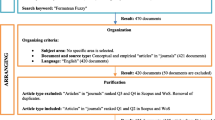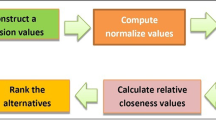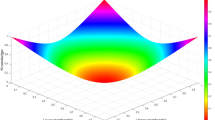Abstract
In an interval-valued Fermatean fuzzy environment, a group decision-making issue relating to data on the disaster preparedness of hospitals is presented in this presentation. Interval-valued Fermatean fuzzy sets have the benefit of being able to accurately reflect the assessment data provided by decision-makers through both qualitative and quantitative elements for the examination of “disaster preparedness of hospitals” challenges. The conventional decision-making techniques will falter, nevertheless, if the dimension and nonlinear connection of the choice data keep expanding. To lower the dimensionality for nonlinear characteristics, we build the interval-valued Fermatean fuzzy linguistic kernel principal component analysis model. In the last part of the study, an illustrative example is given about the method proposed and the assessment of the disaster preparedness of the university hospital according to the hospital management cycle and the detection of its deficiencies. After making a comparison analysis and expressing the advantages of the method, we explained the theoretical, managerial, and political implications of the evaluations to be made with the method we recommend in all hospitals, based on the illustrative example given.



Similar content being viewed by others
References
Zadeh LA (1965) Fuzzy sets. Inf Comput 8:338–353
Tarassenko L, Nairac A, Townsend N, Cowley P (1999) Novelty detection in jet engines. In: IEE colloquium on condition monitoring: machinery, external structures and health (Ref. No. 1999/034), IEE, London, pp 4/1-4/5
Song SO, Shin D, Yoon ES (2001) Analysis of novelty detection properties of autoassociators. In: Starr AG, Rao RBKN (eds) Proceedings of the 14th international congress and exhibition on condition monitoring and diagnostic engineering management (COMADEM). Elsevier Science, Amsterdam, pp 577–584
Atanassov K (1986) Intuitionistic fuzzy sets. Fuzzy Sets Syst 20:87–96
Yager RR (2013) Pythagorean fuzzy subsets. In: Proc. Joint IFSA world congress and NAFIPS annual meeting, Edmonton, Canada
Yager RR (2014) Pythagorean membership grades in multicriteria decision-making. IEEE Trans Fuzzy Syst 22(4):958–965
Boran FE, Genc S, Kurt M, Akay D (2009) A multi-criteria intuitionistic fuzzy group decision making for supplier selection with TOPSIS method. Expert Syst Appl 36(8):11363–11368
Onar SC, Oztaysi B, Kahraman C (2018) Multicriteria evaluation of cloud service providers using Pythagorean fuzzy TOPSIS. J Multiple-Valued Logic Soft Comput 30:263–283
Sajjad A, Khan M, Abdullah S, Yousaf Ali M (2018) Extension of TOPSIS method base on Choquet integral under interval-valued Pythagorean fuzzy environment. J Intell Fuzzy Syst 34(1):267–282
Ghosh I, Biswas S (2017) A novel framework of ERP implementation in Indian SMEs: Kernel principal component analysis and intuitionistic Fuzzy TOPSIS driven approach. Accounting 3:107–118
Lv W, Zeng S, Zhou J, Li T, Koe ASV (2022) Interval-valued Pythagorean fuzzy linguistic KPCA model based on TOPSIS and its application for emergency group decision making. Int J Intell Syst 37:6415–6437. https://doi.org/10.1002/int.22849
Joshi BP (2018) Moderator intuitionistic fuzzy sets with applications in multi-criteria decision-making. Granul. Comput. 3:61–73. https://doi.org/10.1007/s41066-017-0056-3
Joshi BP (2019) Pythagorean fuzzy average aggregation operators based on generalized and group-generalized parameter with application in MCDM problems. Int J Intell Syst 34:895–919
Joshi BP (2016) Interval-valued intuitionistic fuzzysets based method for multiple criteria decision-making. Int J Fuzzy Sys Appl 5(4):192–210
Senapati T, Yager RR (2020) Fermatean fuzzy sets. J. Ambient Intell. Hum. Comput. 11:663–674
Senapati T, Yager RR (2019) Some new operations over Fermatean fuzzy numbers and application of Fermatean fuzzy WPM in multiple criteria decision making. Informatica 30(2):391–412
Senapati T, Yager RR (2019) Fermatean fuzzy weighted averaging/geometric operators and its application in multi-criteria decision-making methods. Eng Appl Artif Intell 85:112–121. https://doi.org/10.1016/j.engappai.2019.05.012
Garg H, Shahzadi G, Akram M (2020) Decision-making analysis based on Fermatean fuzzy Yager aggregation operators with application in COVID-19 testing facility. Math Probl Eng. https://doi.org/10.1155/2020/7279027
Jeevaraj S (2021) Ordering of interval-valued Fermatean fuzzy sets and its applications. Expert Syst Appl 185:115613
Kirisci M (2022) Correlation coefficients of Fermatean fuzzy sets with their application. J. Math. Sci. Model. 5(2):16–23. https://doi.org/10.33187/jmsm.1039613
Kirisci M, Demir I, Simsek N (2022) Fermatean fuzzy ELECTRE multi-criteria group decision-making and most suitable biomedical material selection. Artif Intell Med 127:102278. https://doi.org/10.1016/j.artmed.2022.102278
Kirisci M. Analysis of data on hospital disaster management: a interval-valued Fermatean fuzzy linguistic sets approach. https://www.researchgate.net/publication/365435757_Analysis_of_Data_on_Hospital_Disaster_Management_A_Interval-Valued_Fermatean_Fuzzy_Linguistic_Sets_approach
Liu DH, Liu YY, Chen XH (2019) Fermatean fuzzy linguistic set and its application in multicriteria decisionmaking. Int J Intell Syst 34(5):878–894
Shahzadi G, Akram M (2021) Group decision-making for the selection of an antivirus mask under Fermatean fuzzy soft information. J Intell Fuzzy Syst 40(1):1401–1416
Zeb A, Khan A, Juniad M, Juniad M (2022) Fermatean fuzzy soft aggregation operators and their application in symptomatic treatment of COVID-19 (case study of patients identification). J Ambient Intell Human Comput. https://doi.org/10.1007/s12652-022-03725-z
Greenacre M, Groenen PJF, Hastie T, D’enza AL, Markos A, Tuzhilina E (2022) Principal component analysis. Nat Rev Methods Primers 2:100. https://doi.org/10.1038/s43586-022-00184-w
Zou G, Zhang Q, Peng S, She J, Teng D, Jin C, Che Y (2022) Influence of geological factors on coal permeability in the Sihe coal mine. Int J Coal Sci Technol 9:6. https://doi.org/10.1007/s40789-022-00475-3
Schölkopf B, Smola AJ, Müller K (1998) Nonlinear component analysis as a kernel eigenvalue problem. Neural Comput 10(5):1299–1399
Mika S, Schölkopf B, Smola AJ, Müller K-R, Scholz M, Rätsch G (1999) Kernel PCA and de-noising in feature spaces. Adv Neural Inf Process Syst 11:536–542
Romdhani S, Gong S, Psarrou A (1999) A multi-view nonlinear active shape model using kernel PCA. In: Proceedings of BMVC, Nottingham, UK, pp 483–492
Choi SW, Lee C, Lee J, Hyun J, Lee I (2005) Fault detection and identification of nonlinear processes based on kernel PCA. Chemom Intell Lab Syst 75:55–67. https://doi.org/10.1016/j.chemolab.2004.05.001
Schölkopf B, Mika S, Burges CJC, Knirsch P, Müller K-R, Rätsch G, Smola AJ (1999) Input space versus feature space in kernel-based methods. IEEE Trans Neural Netw 10(5):1000–1016
Haykin S (1999) Neural networks. Prentice-Hall, Englewood Cliffs, NJ
Azarmi S, Sharififar S, Pishgooie AH, Khankeh HR, Hejrypour SZ (2022) Hospital disaster risk management improving strategies: a systematic review study. Am J Disaster Med [S.l.] 17(1):75–89. https://doi.org/10.5055/ajdm.2022.0421
Ortiz-Barrios M, Gul M, Lopez-Meza P, Yucesan M, Navarro-Jiménez E (2020) Evaluation of hospital disaster preparedness by a multi-criteria decision making approach: the case of Turkish hospitals. Int J Disaster Risk Reduct 49:101748
Ortiz-Barrios M, Gul M, Yucesan M, Alfaro-Sarmiento I, Navarro-Jiménez E, Jiménez-Delgado G (2022) A fuzzy hybrid decision-making framework for increasing the hospital disaster preparedness: the Colombian case. Int J Disaster Risk Reduct 72:102831
Ozbey S, Baskak D, Saner HS, Yucesan M, Erdogan M, Gul M (2022) A brief review of the applications of MCDA in disaster management. In: Multi-criteria decision analysis: case studies in disaster management, Chapter 1, CRC Press
Lo H-W, Erdogan M, Yucesan M, Gul M (2022) Emergency department preparedness assessment for outbreaks by a combined Bayesian BWM-RIM model. In: Multi-criteria decision analysis: case studies in disaster management, Chapter 12, CRC Press
Saner HS, Yucesan M, Gul M (2022) A Bayesian BWM and VIKOR-based model for assessing hospital preparedness in the face of disasters. Nat Hazards 111:1603–1635. https://doi.org/10.1007/s11069-021-05108-7
Jung Y (2022) Virtual reality simulation for disaster preparedness training in hospitals: integrated review. J Med Internet Res 24(1):e30600. https://doi.org/10.2196/30600
Moheimani A, Sheikh R, Hosseini SMH, Sana SS (2021) Assessing the agility of hospitals in disaster management: application of interval type-2 fuzzy Flowsort inference system. Soft Comput 25:3955–3974. https://doi.org/10.1007/s00500-020-05418-1
Hwang CL, Yoon K (1981) Multiple attributes decision making methods and applications. Springer, Berlin Heidelberg
Chen CT (2000) Extensions of the TOPSIS for group decision making under fuzzy environment. Fuzzy Sets Syst 114:1–9
Chen TY, Tsao CY (2008) The interval-valued fuzzy TOPSIS method and experimental analysis. Fuzzy Sets Syst 159(11):1410–1428
Xu Z, Zhang X (2013) Hesitant fuzzy multi-attribute decision making based on TOPSIS with incomplete weight information. Knowl-Based Syst 52:53–64
Beg I, Rashid T (2013) TOPSIS for hesitant fuzzy linguistic term sets. Int J Intell Syst 28(12):1162–1171
Broumi S, Ye J, Smarandache F (2015) An extended TOPSIS method for multiple attribute decision making based on interval neutrosophic uncertain linguistic variables. Neutrosophic Sets Syst 8:22–31. https://doi.org/10.5281/zenodo.571233
Gündoğdu FK, Kahraman C (2019) Spherical fuzzy sets and spherical fuzzy TOPSIS method. J Intell Fuzzy Syst 36:337–352
Gündoğdu FK, Kahraman C (2019) A novel fuzzy TOPSIS method using emerging interval-valued spherical fuzzy sets. Eng Appl Artif Intell 85:307–323
Zadeh LA (1975) The concept of a linguistic variable and its application to approximate reasoning-I. Inf Sci 8(3):199–249
Xu Z (2004) A method based on linguistic aggregation operators for group decision making with linguistic preference relations. Inf Sci 166(1–4):19–30
Xu Z (2015) Uncertain multi-attribute decision making: methods and applications. Springer, Berlin, Gerrmany
Xinmin Tao A, Rui Chang B, Chenxi Li C, Ruotong Wang D, Rui Liu E (2019) Density-sensitive robust fuzzy kernel principal component analysis technique. Neurocomputing 329:210–226. https://doi.org/10.1016/j.neucom.2018.10.052
Author information
Authors and Affiliations
Contributions
MK and NS wrote the main manuscript text. All authors reviewed the manuscript.
Corresponding author
Ethics declarations
Conflict of interest
The authors declare no conflict of interest.
Additional information
Publisher's Note
Springer Nature remains neutral with regard to jurisdictional claims in published maps and institutional affiliations.
Rights and permissions
Springer Nature or its licensor (e.g. a society or other partner) holds exclusive rights to this article under a publishing agreement with the author(s) or other rightsholder(s); author self-archiving of the accepted manuscript version of this article is solely governed by the terms of such publishing agreement and applicable law.
About this article
Cite this article
Kirişci, M., Simsek, N. A novel kernel principal component analysis with application disaster preparedness of hospital: interval-valued Fermatean fuzzy set approach. J Supercomput 79, 19848–19878 (2023). https://doi.org/10.1007/s11227-023-05395-w
Accepted:
Published:
Issue Date:
DOI: https://doi.org/10.1007/s11227-023-05395-w




